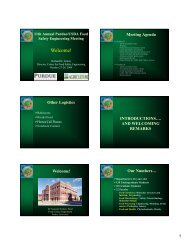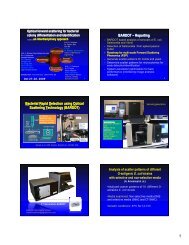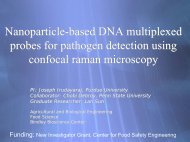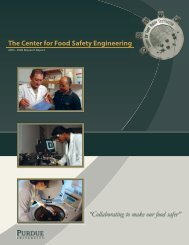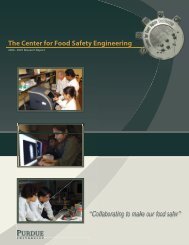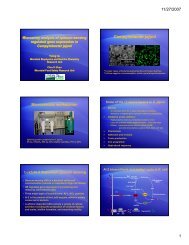Annual Report - Center for Food Safety Engineering - Purdue ...
Annual Report - Center for Food Safety Engineering - Purdue ...
Annual Report - Center for Food Safety Engineering - Purdue ...
You also want an ePaper? Increase the reach of your titles
YUMPU automatically turns print PDFs into web optimized ePapers that Google loves.
Park, Leary and AronsonField-ready biosensors <strong>for</strong> high throughput andmultiplexed detection of foodborne pathogensInvestigators: Kinam Park (Department of Biomedical <strong>Engineering</strong>), James Leary (Department of Biological<strong>Engineering</strong>), Arthur Aronson (Department of Biological Sciences)Project RationaleThe increased incidence of pathogen-contaminated food placesa new emphasis on the rapid detection and quantifi cation offoodborne pathogens. There<strong>for</strong>e, we are developing a surfaceplasmon resonance (SPR) imaging biosensor <strong>for</strong> the rapid, labelfree,and high throughput detection of foodborne pathogens. Thisdevice integrates an SPR imaging system with a biosensor arrayimmobilized onto a sample surface containing specifi c shortpeptide ligands. A group of short peptides specifi c to certainpathogenic bacteria will be microcontact-printed on a gold chipin linear patterns. This peptide-imprinted gold chip functions as abiosensor array <strong>for</strong> the specifi c detection of unknown foodbornepathogens. To determine what fraction of pathogenic bacteriaare live or dead and to confi rm the SPR results, we have createda novel hybrid SPR/molecular imaging portable system.The device would offer a commercial advantage to the foodprocessing industry. It is miniaturized, has fewer components,and is easier to use compared to the current detection systems.This biosensor would detect foodborne pathogens present in



